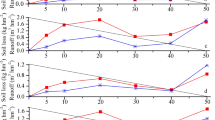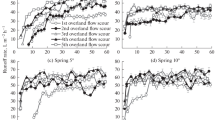Abstract
Purpose
The influence of slope gradient on interrill erosion processes is a key scientific problem in the decision-making process regarding soil erosion control in Loess Plateau. The relationship of time to runoff (RT), flow velocity (V), runoff rate (RR) and interrill erosion rate (IER) with slope gradient was investigated to derive accurate experimental model to evaluate and quantify the influence of slopes on interrill erosion processes.
Materials and methods
The experimental soil was collected from Ansai County of Shaanxi Province, China. The average diameter of the test soil was 0.041 mm. The experiment was conducted at slopes of 8.74%, 17.62%, 26.78%, 36.38%, 46.6%, 57.70% and 69.97% under I of 90, 120 and 150 mm h−1, respectively, using indoor simulated rainfall. Time to runoff, flow velocity, runoff rate and interrill erosion rate were measured for each combination.
Results and discussion
Results showed that the time to runoff decreased as a linear function with increasing slope gradient. Slope gradient was a good predictor of time to runoff for different rainfall intensities with NSE from 0.90 to 0.97 and MSE from 0.1 to 0.25 and R2 from 0.90 to 0.97. The flow velocity increased as a power function with increasing slope gradients. Slope gradient was a good predictor of flow velocity for different rainfall intensities with NSE from 0.91 to 0.93 and MSE from 0.01 to 0.015 and R2 from 0.95 to 0.98. The runoff rate increased as a power function with increasing slope gradients. Slope gradient was a good predictor of runoff rate for different rainfall intensities with NSE from 0.90 to 0.95 and MSE from 0.000000024 to 0.000000044 and R2 from 0.94 to 0.97. The interrill erosion rate increased as a power function with increasing slope gradients. Slope gradient was a good predictor of interrill erosion rate for different rainfall intensities with NSE from 0.98 to 0.99 and MSE from 0.00022 to 0.00055 and R2 from 0.98 to 0.99.
Conclusions
By performing the controlled simulated rainfall experiments, this study showed that slopes strongly influenced interrill erosion processes for different rainfall intensities.




Similar content being viewed by others
References
Ahmad N, Hafiz M, Sinclair A, Jamieson R, Madani A, Hebb D, Yiridoe EK (2011) Modeling sediment and nitrogen export from a rural watershed in Eastern Canada using the soil and water assessment tool. J Environ Quality 40:1182–1194
An J, Zheng F, Lu J, Li G (2012) Investigating the role of raindrop impact on hydrodynamic mechanism of soil erosion under simulated rainfall conditions. Soil Sci 177:517–526
Armstrong A, Quinton JN, Heng BCP, Chandler JH (2011) Variability of interrill erosion at low slopes. Earth Surf Process Land 36:97–106
Ali M, Sterk G, Seeger M, Boersema MP, Peters P (2011) Effect of hydraulic parameters on sediment transport capacity in overland flow over erodible beds. Hydrol Earth Syst Sci Discuss 8:6939–6965
Assouline S, Ben-Hur M (2006) Effects of rainfall intensity and slope gradient on the dynamics of interrill erosion during soil surface sealing. Catena 66:211–220
Ben-Hur M, Wakindiki IIC (2004) Soil mineralogy and slope effects on infiltration, interrill erosion, and slope factor. Water Resour Res 40:1–8
Cao L, Zhang K, Dai H, Liang Y (2015) Modeling interrill erosion on unpaved roads in the loess plateau of China. Land Degrad Dev 26:825–832
Ding W, Huang C (2017) Effects of soil surface roughness on interrill erosion processes and sediment particle size distribution. Geomorphology 295:801–810
Fox DM, Bryan RB (2000) The relationship of soil loss by interrill erosion to slope gradient. Catena 38:211–222
Fu S, Liu B, Liu H, Xu L (2011) The effect of slope on interrill erosion at short slopes. Catena 84:29–34
Giménez R, Govers G (2001) Interaction between bed roughness and flow hydraulics in eroding rills. Water Resour Res 37:791–799
Govers G (1992) Relationship between discharge, velocity and flow area for rills eroding loose, non-layered materials. Earth Surf Proc Land 17:515–528
Guanghui Z, Yimin L (1995) Study on runoff beginning time of artificial grassland in loess hilly region. J Soil Water Conserv 9:78–83
Huang CH, Bradford JM (1993) Analyses of slope and runoff factors based on the WEPP erosion model. Soil Sci Soc Am J 57:1176–1183
Lado M, Ben-Hur M, Shainberg I (2004) Soil wetting and texture effects on aggregate stability, seal formation, and erosion. Soil Sci Soc Am J 68:1992–1999
Li C, Holden J, Grayson R (2018) Effects of rainfall, overland flow and their interactions on peatland interrill erosion processes. Earth Surf Proc Land 43:1451–1464
Li G, Abrahams AD (1999) Controls of sediment transport capacity in laminar interrill flow on stone-covered surfaces. Water Resour Res 5(1):305–310
Li M, Yao W, Li Z (2005) Progress of the effect of grassland vegetation for conserving soil and water on loess plateau. Adv Earth Sci 20:74–080
Liu G, Xu WN, Zhang Q, Xia ZY (2012a) Interrill and rill erosion on hillslope. Appl Mech Mater 170–173:1344–1347
Liu H, Lei TW, Zhao J, Yuan CP, Fan YT, Qu LQ (2011) Effects of rainfall intensity and antecedent soil water content on soil infiltrability under rainfall conditions using the run off-on-out method. J Hydrol 396:24–32
Liu Y, Fu B, Lü Y, Wang Z, Gao G (2012b) Hydrological responses and soil erosion potential of abandoned cropland in the Loess Plateau, China. Geomorphology 138:404–414
Moriasi DN, Arnold JG, Van Liew MW, Bingner RL, Harmel RD, Veith TL (2007) Model evaluation guidelines for systematic quantification of accuracy in watershed simulations. T ASABE 50:885–900
Nash JE, Sutcliffe JV (1970) River flow forecasting through conceptual models part I—a discussion of principles. J Hydrol 10:282–290
Nearing MA, Norton LD, Bulgakov DA, Larionov GA, West LT, Dontsova KM (1997) Hydraulics and erosion in eroding rills. Water Resour Res 33:865–876
Nearing MA, Simanton JR, Norton LD, Bulygin SJ, Stone J (1999) Soil erosion by surface water flow on a stony, semiarid hillslope. Earth Surf Process Landf: J Br Geomorph Res Group 24:677–686
Shen H, Zheng F, Wen L, Han Y, Hu W (2016) Impacts of rainfall intensity and slope gradient on rill erosion processes at loessial hillslope. Soil Tillage Res 155:429–436
Shi H, Shao M (2000) Soil and water loss from the Loess Plateau in China. J Arid Environ 45:9–20
Shi ZH, Yue BJ, Wang L, Fang NF, Wang D, Wu FZ (2013) Effects of mulch cover rate on interrill erosion processes and the size selectivity of eroded sediment on steep slopes. Soil Sci Soc Am J 77:257–267
Takken I, Govers G, Ciesiolka CAA, Silburn DM, Loch RJ (1998) Factors influencing the velocity-discharge relationship in rills. IAHS Publication, p 63–70
Vaezi AR, Ahmadi M, Cerdà A (2017) Contribution of raindrop impact to the change of soil physical properties and water erosion under semi-arid rainfalls. Sci Total Environ 583:382–392
Wang D, Wang Z, Zhang Q, Zhang Q, Tian N, Liu JE (2018) Sheet erosion rates and erosion control on steep rangelands in loess regions. Earth Surf Proc Land 43:2926–2934
Wu B, Wang Z, Shen N, Wang S (2016) Modelling sediment transport capacity of rill flow for loess sediments on steep slopes. Catena 147:453–462
Wu B, Wang Z, Zhang Q, Shen N (2018) Distinguishing transport-limited and detachment-limited processes of interrill erosion on steep slopes in the Chinese loessial region. Soil Tillage Res 177:88–96
Wu B, Wang Z, Zhang Q (2017a) Modelling sheet erosion on steep slopes in the loess region of china. J Hydrol 553:549–558
Wu L, Wang S, Bai X, Luo W, Tian Y, Zeng C, He S (2017b) Quantitative assessment of the impacts of climate change and human activities on runoff change in a typical karst watershed, SW China. Sci Total Environ 601:1449–1465
Wu S, Yu M, Chen L (2017c) Nonmonotonic and spatial-temporal dynamic slope effects on soil erosion during rainfall-runoff processes. Water Resour Res 53:1369–1389
Yang Y, Ye Z, Liu B, Zeng X, Fu S, Lu B (2014) Nitrogen enrichment in runoff sediments as affected by soil texture in Beijing mountain area. Environ Monit Assess 186:971–978
Zhang Q, Wang Z, Guo Q, Tian N, Shen N, Liu JE (2019) Plot-based experimental study of raindrop detachment, interrill wash and erosion-limiting degree on a clayey loessal soil. J Hydrol 575:1280–1287
Zhang Q, Xu CY, Zhang Z, Chen X, Han Z (2010) Precipitation extremes in a karst region: a case study in the Guizhou province, southwest China. Theor Appl Climatol 101:53–65
Zhang XC, Liu WZ, Li Z, Zheng FL (2009) Simulating site-specific impacts of climate change on soil erosion and surface hydrology in southern Loess Plateau of China. Catena 79:237–242
Zhang XJ, Wang ZL (2017) Interrill soil erosion processes on steep slopes. J Hydrol 548:652–664
Zhang XC (2019) Determining and modeling dominant processes of interrill soil erosion. Water Resour Res 55:4–20
Zhao G, Mu X, Wen Z, Wang F, Gao P (2013) Soil erosion, conservation, and eco-environment changes in the Loess Plateau of China. Land Degrad Dev 24:499–510
Zhao L, Liang X, Wu F (2014) Soil surface roughness change and its effect on runoff and erosion on the Loess Plateau of China. J Arid Land 6:400–409
Zhuang X, Wang W, Ma Y, Huang X, Lei T (2018) Spatial distribution of sheet flow velocity along slope under simulated rainfall conditions. Geoderma 321:1–7
Funding
Financial support for this research was provided by the National Natural Science Foundation of China–funded project (41907046, 41790441, 41772316, 41830758); project funded by the China Postdoctoral Science Foundation (2018M640998); project supported by the State Key Laboratory of Earth Surface Processes and Resource Ecology (2020-KF-08); project supported by the State Key Laboratory of Soil Erosion and Dryland Farming on the Loess Plateau (A314021402-2001); and the National Key Research and Development Program of China (2018YFC1504701).
Author information
Authors and Affiliations
Corresponding authors
Additional information
Responsible editor: Lu Zhang
Publisher's Note
Springer Nature remains neutral with regard to jurisdictional claims in published maps and institutional affiliations.
Rights and permissions
About this article
Cite this article
Wu, B., Li, L., Xu, L. et al. The influence of slopes on interrill erosion processes using loessial soil. J Soils Sediments 21, 3672–3681 (2021). https://doi.org/10.1007/s11368-021-03018-6
Received:
Accepted:
Published:
Issue Date:
DOI: https://doi.org/10.1007/s11368-021-03018-6




